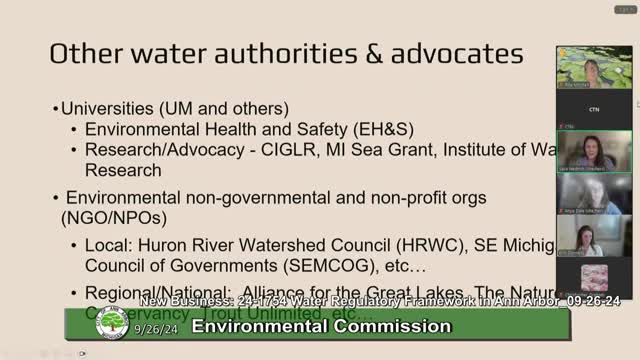Michigan Takes Bold Steps to Combat PFAS Contamination
September 26, 2024 | Ann Arbor City, Washtenaw County, Michigan
This article was created by AI summarizing key points discussed. AI makes mistakes, so for full details and context, please refer to the video of the full meeting. Please report any errors so we can fix them. Report an error »

In a recent government meeting, officials discussed critical environmental issues affecting water quality in Michigan, particularly focusing on the regulation of PFAS (per- and polyfluoroalkyl substances), nutrient pollution, and pesticide regulations.
The meeting highlighted Michigan's proactive stance on PFAS regulation, with the state being one of the first to establish maximum contaminant limits (MCLs) for these harmful substances in drinking water. Advocacy from local groups prompted the state's drinking water division to monitor PFAS levels, leading to the detection of these chemicals in Ann Arbor's water supply. The formation of the Michigan PFAS Action Response Team (MPART) has facilitated collaboration among various state agencies to address PFAS contamination, including compliance actions against identified sources like TriBAR, which was linked to PFAS discharges into the Huron River.
Additionally, the meeting addressed the ongoing challenge of nutrient pollution in the Port and Belleville Lakes, where harmful algal blooms have historically impaired water quality. The city has implemented a phosphorus ordinance and collaborated with regional partners to reduce phosphorus levels entering the river. Recent efforts include a memorandum of understanding with Ypsilanti Township to enhance water quality monitoring in Ford Lake.
The discussion also touched on the regulation of neonicotinoid pesticides, which have been linked to bee population declines. While the EPA continues to allow their use, state agencies are beginning to monitor surface water for pesticide levels, raising concerns about their impact on aquatic life. The limited regulatory authority over agricultural practices complicates efforts to manage these pollutants effectively.
Participants expressed the need for improved coordination among various regulatory agencies to expedite responses to emerging environmental issues. Questions were raised regarding the implications of recent Supreme Court decisions on water regulation and the management of invasive species, highlighting the complexity of environmental governance in Michigan.
Overall, the meeting underscored the importance of collaborative efforts among local, state, and federal agencies to address water quality challenges and protect Michigan's natural resources.
The meeting highlighted Michigan's proactive stance on PFAS regulation, with the state being one of the first to establish maximum contaminant limits (MCLs) for these harmful substances in drinking water. Advocacy from local groups prompted the state's drinking water division to monitor PFAS levels, leading to the detection of these chemicals in Ann Arbor's water supply. The formation of the Michigan PFAS Action Response Team (MPART) has facilitated collaboration among various state agencies to address PFAS contamination, including compliance actions against identified sources like TriBAR, which was linked to PFAS discharges into the Huron River.
Additionally, the meeting addressed the ongoing challenge of nutrient pollution in the Port and Belleville Lakes, where harmful algal blooms have historically impaired water quality. The city has implemented a phosphorus ordinance and collaborated with regional partners to reduce phosphorus levels entering the river. Recent efforts include a memorandum of understanding with Ypsilanti Township to enhance water quality monitoring in Ford Lake.
The discussion also touched on the regulation of neonicotinoid pesticides, which have been linked to bee population declines. While the EPA continues to allow their use, state agencies are beginning to monitor surface water for pesticide levels, raising concerns about their impact on aquatic life. The limited regulatory authority over agricultural practices complicates efforts to manage these pollutants effectively.
Participants expressed the need for improved coordination among various regulatory agencies to expedite responses to emerging environmental issues. Questions were raised regarding the implications of recent Supreme Court decisions on water regulation and the management of invasive species, highlighting the complexity of environmental governance in Michigan.
Overall, the meeting underscored the importance of collaborative efforts among local, state, and federal agencies to address water quality challenges and protect Michigan's natural resources.
View full meeting
This article is based on a recent meeting—watch the full video and explore the complete transcript for deeper insights into the discussion.
View full meeting
